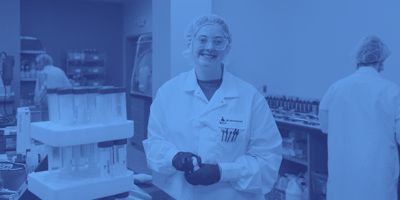During the second half of 2023, the Association for the Advancement of Medical Instrumentation...
Understanding ST108 in 2025
This post is a follow-up to our July 2024 blog, Understanding the Fundamental Principles of the ST108 Standard. While there have been no official updates to the standard itself since its publication, this article dives deeper into its key components, testing requirements, and what they mean for water quality compliance, especially as more accreditation bodies begin to adopt ST108 as a requirement.
Why Does ST108 Matter?
As we shared with you in July of last year, in late 2023, the Association for the Advancement of Medical Instrumentation (AAMI) published their guidance for medical facility water quality. This standard was developed to help minimize hospital-acquired infections through full lifecycle management of sterile processing areas. This standard builds upon previously published TIR 34, but goes further in defining cleaning procedures, sterilization methods, disinfection guidance, quality control requirements, and associated documentation.
In addition to these changes, regulatory and accreditation bodies are adopting this currently voluntary standard as requirements for accreditation, the largest of such so far being The Joint Commission, which is responsible for the accreditation of over 22,000 medical facilities worldwide.
What Changes With This Standard?
ST108 developed three categories of water within the reusable medical device sector:
- Critical Water – water mainly used in final rinse after high-level disinfection, final rinse for critical devices prior to sterilization, and feedwater for process steam production.
- Utility Water – water used in flushing, washing, and immediate rinsing between cleaning and disinfecting. This water is typically supplied via tap.
- Steam – vaporized water produced by a centralized boiler or localized generator.
With the definition of these three categories also comes requirements for testing and water quality parameters. Critical water, being the water of greatest concern, requires monthly monitoring to ensure the highest level of care is provided to the devices that will directly contact patients in the most exposed manner. Utility and steam, carrying slightly less risk, are required to test on a quarterly basis.
To be in compliance with the standard, these samples must meet the following targets:
|
Parameter |
Monthly Critical Water |
Quarterly Utility Water |
Quarterly Steam |
|
pH |
5.0-7.5 SU |
6.5-9.5 SU |
5.0-9.2 SU |
|
Conductivity |
<10 µS/cm |
<500 µS/cm |
<10 µS/cm |
|
Total Alkalinity |
<8 mg/L |
<400 mg/L |
<8 mg/L |
|
Total Hardness (Ca & Mg) |
<1.0 mg/L |
<150 mg/L |
<1 mg/L |
|
HPC Bacteria – Pour Plate R2A |
<10 CFU/ml |
<500 CFU/ml* |
N/A |
|
Endotoxin |
<10 EU/ml |
N/A* |
N/A |
*When Utility Water is used after chemical high-level disinfection as a final rinse, the bacteria should be <10 CFU/mL and endotoxin <10 EU/mL
In addition to routine testing, annual validations are necessary. These annual validations take the testing a step further by evaluating additional ionic and organic analyses that can contribute to medical device fouling, damage, or patient risk. Each water category has its own targets upon annual validation, which are found below:
|
Parameter |
Critical Water |
Utility Water |
Steam |
|
pH |
5.0-7.5 SU |
6.5-9.5 SU |
5.0-9.2 SU |
|
Conductivity |
<10 µS/cm |
<500 µS/cm |
<10 µS/cm |
|
Total Alkalinity |
<8 mg/L |
<400 mg/L |
<8 mg/L |
|
HPC Bacteria – Pour Plate R2A |
<10 CFU/ml |
<500 CFU/ml* |
N/A |
|
Endotoxin |
<10 EU/ml |
N/A* |
N/A |
|
Chloride |
<1 mg/L |
<250 mg/L |
<1 mg/L |
|
Nitrate |
<10 mg/L |
<1 mg/L |
<1 mg/L |
|
Phosphate |
<5 mg/L |
<1 mg/L |
<1 mg/L |
|
Sulfate |
<150 mg/L |
<1 mg/L |
<1 mg/L |
|
Total Hardness (Ca & Mg) |
<1.0 mg/L |
<150 mg/L |
<1 mg/L |
|
Copper |
<0.1 mg/L |
<0.1 mg/L |
<0.1 mg/L |
|
Iron |
<0.1 mg/L |
<0.1 mg/L |
<0.1 mg/L |
|
Manganese |
<0.1 mg/L |
<0.1 mg/L |
<0.1 mg/L |
|
Aluminum |
<.1 mg/L |
<.1 mg/L |
<.1 mg/L |
|
Silicate |
<50 mg/L |
<1 mg/L |
<1 mg/L |
|
Zinc |
<0.1 mg/L |
<0.1 mg/L |
<0.1 mg/L |
|
TOC |
<1.0 mg/L |
N/A |
N/A |
|
Color & Turbidity |
Colorless without sediment |
||
ST108 & Q Labs – How Can We Help?
At Q Laboratories, we bring over 50 years of water testing experience to the table. While ST108 may be new, the testing it requires is not. Every parameter outlined in the standard is already well within our wheelhouse. We've been performing these analyses for decades, long before they were mandatory.
- ST108-compliant testing for all three water categories
- Routine monitoring and annual validations
- Clear, accurate reporting to support audits and accreditation
- Fast turnaround times and responsive support
Whether you're preparing for an audit or building a compliant water monitoring program, our team is here to help. Get in touch with our team to streamline your ST108 testing today!
Want to dive even deeper?
Join us on Wednesday, May 14th at 1 PM ET for a free webinar presented by Michael Loewenstein, VP of Scientific Consulting, and Scott Gallmeier, Director of Business Development – Water Treatment.
Designed for water treatment and healthcare professionals managing water systems, this session will help you better understand and apply the ST108 Standard. Plus, you’ll have the opportunity to ask questions directly to our water testing experts.

.png?height=200&name=ST-108%20Blog%20Image%20(new).png)

.png?height=200&name=ISO%20Blog%20Image%20(New).png)